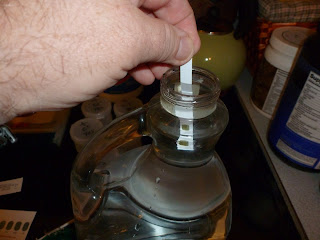Joey gave me a handful of test strips to bring home and I set up a counter top chemistry lab.
In the photo below the actual unused test strip is at the lower left and the chart for interpreting values is in the center of the photo. If you can make out the markings, from left to right, as the colored ovals progress from yellow to blue, the values go from 0 to 0.2 mg/L. The World Health Organization set 2.5 mg/L as the target level for chlorine residuals in treated water.
The fact that these test strips are off by one full order of magnitude does not render them useless. For starters, I can mix a batch of rainwater on a smaller scale to the same concentration as I would in the barrel, just scaling back the amount I add proportional to the size of the batch I am making then test. If our calculations are correct, and there are no other errors in either our assumptions or our methods, then the sample should overshoot the test strip and it should turn it dark blue. Bad if we are doing dialysis; good if we are disinfecting water for drinking purposes. So, following this reasoning, I mixed up a fresh batch of water, using a TB syringe to add 0.15 ml of 8.25% bleach to 2.65 L of water. This mixture is actually rather rich and should produce a chlorine level of between 4 and 5 mg/L. After letting it stand for a few minutes I
The reading should be a robust blue of a shade equal to, or darker, than the last oval on the right. As you can see, it clearly is not. It reads right on 0.05 mg/L. What is interesting about this error is that it is numerically correct, only that it is off by two orders of magnitude (factor of 100x). This leads me to believe that somewhere in the calculations is a unit conversion error, but I will be damned if I can find it. I have re-run the numbers more than once and don't see it.
On the up side, though, is that I have a plan for tomorrow. I will first add 5.8 ml of bleach to the barrel and take samples; then I will add another 52 ml (for a total of 58 ml) or 10 times as much and take samples; then finally, I will add 520 ml of bleach (for a total of ~580 ml of bleach) or 100 times as much and again sample. If it is simply a unit conversion error in our calculations this should reveal it. I am, however, leery about this as it would entail adding a liter of bleach to every 55 gallon drum. This seems to fly in the face of more conventional doses that I have found online at the WHO and other websites that start with 1% stock solutions and add amounts on the order of 20 ml to a 45 gallon drum. Something just is not adding up and we need to rectify it quickly.




No comments:
Post a Comment